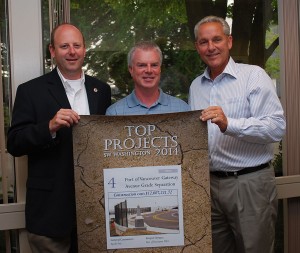West Vancouver Freight Access Project receives Top Project award

Key project staff pose with the Top Projects award. Left to right: Monty Edberg, Greg Westrand and Alan Hargrave
The Port of Vancouver USA’s West Vancouver Freight Access Project (WVFA) was recognized by the Vancouver Business Journal as one of Southwest Washington’s top projects for 2013-2014!
The WVFA is a multi-phase, $275 million rail mobility and economic development project. A recently completed element of the project, the Gateway Avenue Overpass, was one of more than a dozen commercial, public works and residential projects recognized at the VBJ’s annual Top Projects Awards ceremony on July 23.
Commissioners Brian Wolfe and Nancy Baker accepted the award on behalf of all the port staff, contractors and consultants who designed and constructed the overpass. Commissioner Jerry Oliver was also in attendance.
The port worked with 45 businesses throughout the two-year-long, $15.9 million Gateway Overpass project. These businesses are part of a larger group of 167 contractors and consultants who have worked on the WVFA project to date.
The Port of Vancouver is constructing the WVFA in phases as funds become available. The Gateway Avenue Overpass, a bridge taking vehicular traffic up and over two sets of railroad tracks just south of the port’s busy main gate, was one project in the larger “corridor phase.”
By eliminating vehicle/train conflicts, the Gateway Overpass improves safety and mobility for all traffic at this historical chokepoint.
Local improvements, national benefits
The WVFA increases the efficiency of rail movement in multiple areas within the port, providing port tenants and customers with a critical transportation advantage and helping them remain competitive in the global marketplace.
An economic engine on all sides, the WVFA is expected to:
- Generate nearly $400 million in private-sector investment
- Create approximately 4,000 construction jobs from start to finish
- Create between 1,000 and 2,000 new, permanent jobs
- Increase the port’s internal track miles from 16 to over 50, providing more efficient rail access to port marine terminals
- Generate significant tax revenue for local and state governments by attracting new business
- Enhance the port’s internal rail system, benefiting existing and future tenants
- Provide dual Class 1 rail carrier access to the port, making the port more competitive when attracting new businesses
- Remove a significant chokepoint from the regional rail system, freeing up tracks for both freight and passenger rail
- Reduce congestion on BNSF Railway and Union Pacific mainlines by as much as 40 percent upon completion
- Allow full unit trains carrying a single product to be handled within the port
- Significantly increase the port’s capacity to handle rail cars
- Benefit the development of the Pacific Northwest Rail Corridor — one of 10 designated potential high-speed rail corridors of national significance — by reducing congestion
- Enable the City of Vancouver to develop its waterfront by removing a section of track that bisected city property
In a “no stone unturned” approach, the Port of Vancouver is investing port revenue and taxes, leveraging private-sector investment, and seeking federal and state funding to bring this critical rail investment to fruition.
Construction on the WVFA began in 2009. The overall project is more than 50 percent complete, and the port expects to reach full completion in 2017.
The port extends a big thank-you to all the contractors and consultants who have worked so hard on the WVFA. This critical rail project is an ongoing success story because of your diligence and commitment to making our community a great place to do business!
